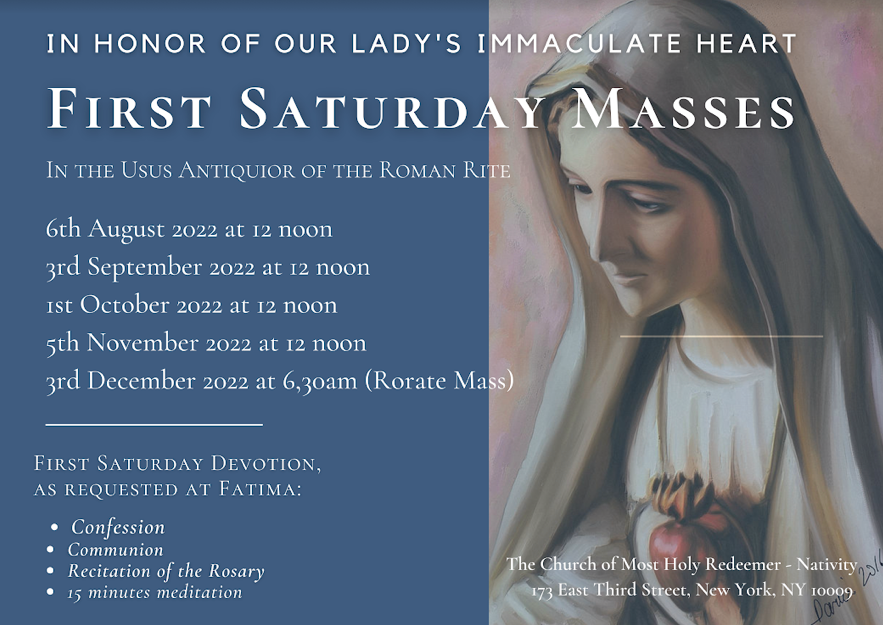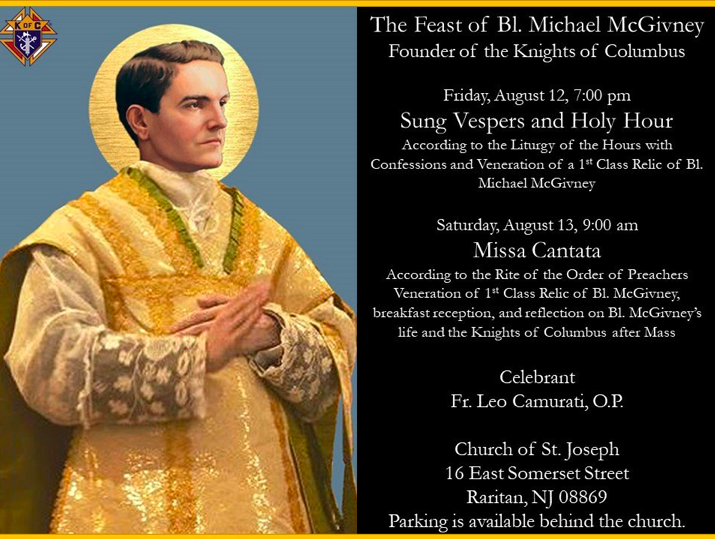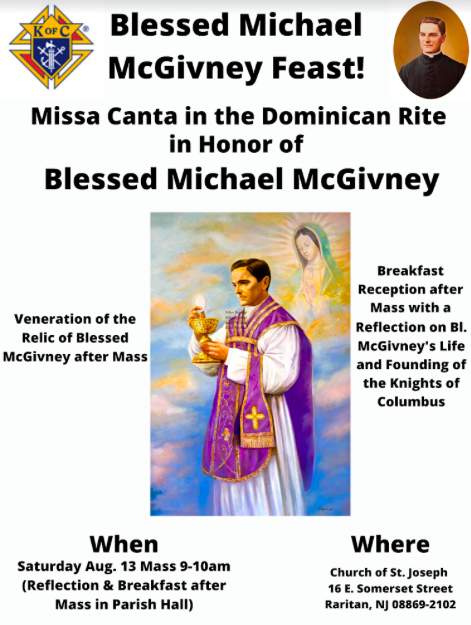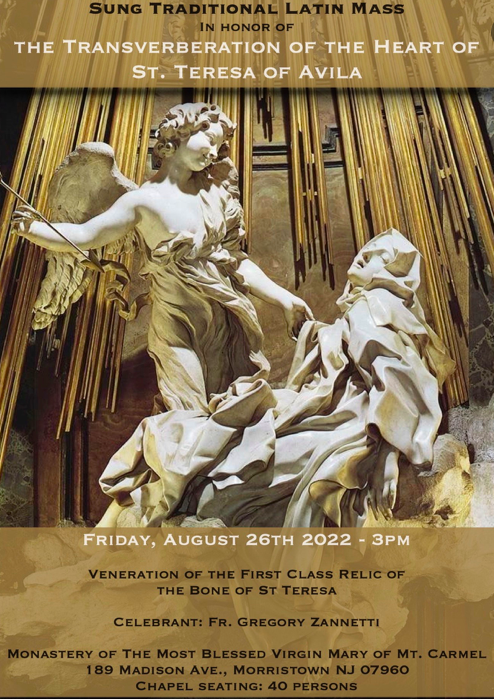
13
Aug
7
Aug

Sermon for the Ninth Sunday after Pentecost
By Father Richard Cipolla
And they will not leave one stone upon another in you; because you did not know the time
of your visitation.
Today’s gospel is not a parable, it is not a specific teaching of Jesus. It is one of the most
dramatic scenes in the Gospel: Jesus’ weeping over Jerusalem as he enters the city and
the driving out of the money changers from the Temple. What can we make of this
scene? What does it mean for us? It is true that it describes a particular event in Jesus’
history and that it can be analyzed in this way. But the gospel at Mass is not merely to
give information of Jesus’ life. The gospel is the making present of Christ as the living
Word, that Word that has to speak to us and penetrate our hearts.
The context is always important. Jesus weeps over Jerusalem as he enters the holy city
on Palm Sunday. This is the beginning of the events of the Passion and Death of the
Lord. Despite the shouts of hosannas from the crowd, Jesus knows that he enters
Jerusalem for the last time, that this entrance is the beginning of those events that will
lead to his crucifixion. The hosannas break his heart, for he knows that they bear no
meaning, he knows that his preaching and teaching has not borne fruit among his own
people, he knows that the very religious and political center of his people has rejected
him and await to do what has to be done to get rid of him. And he feels the deep irony:
the city whose name bears the name of peace, jeru shalom, has not a clue as to what
peace is all about, that peace that is the very presence of God. And he predicts the
destruction of the city and therefore the religious heart of the city, the temple, with its
symbol of the presence of God, with its daily offerings of animal sacrifices for the sins of
the people. And he weeps, he weeps because Jerusalem did not recognize the time of its
visitation, that is, the moment when the very truth and peace of God tented among his
people to give them that salvation for which they always longed.
Jesus goes right up to the temple, for there is the heart of the matter, there is where the
presence of God was, there the teaching of the Law, there the sacrifices for sin. And the
Lord comes to his temple. He came into this temple when he was a baby, when Mary and
Joseph brought him to be redeemed and blessed forty days after his birth, that event we
commemorate every year as the Feast of the Presentation in the Temple, or Candlemass,
when we hear Simeon’s song,” Lord now lettest thou thy servant depart in peace. For my
eyes have seen thy salvation”. And now he comes to the temple to do what has to be
done before he starts on the road to Calvary: to teach and preach within this center of the
Jewish faith and culture, to teach and preach not as one of the scribes or Pharisees, but
with the authority of God himself.
But before he begins this last phase of his life, he cleanses the temple by driving out the
sellers and money changers. “My house shall be a house of prayer; you have made it a
den of robbers”. Who were these sellers and money changers? They were in the temple
precincts for practical reasons: they sold the small and big animals that the people would then bring to the priest to offer as a sacrifice for their sins. And the money changers were there to make sure that everyone had the right change to pay the one shekel temple tax.
They must have been there in the past times Jesus had visited the temple. But this time
was different: The line from the temple to the Cross was in place: the symbolic presence
of God in the temple, the daily sacrifices: all these shadows were about to be replaced
with the reality of the fullness of the truth of God and the Lamb of God who will offer
himself once and for all for the sins of the world. So the cleansing of the temple is a
symbolic act, the signal that the end of the shadows had come and the beginning of the
light of God in the world as a real presence.
“Types and shadows have their ending”, so wrote St Thomas Aquinas. The temple was
razed to the ground by the Romans in 70 AD and was never rebuilt. And the Christian
understanding is that the Church took the place of the temple, for it is the Church as the
body of Christ in which the real presence of God in Word and Sacrament is known and
experienced in the world of time and place, the world of history. And it is the worship of
the Church that fulfills the daily sacrifices of the temple by the Mass, which is the
renewal of the one, true and eternal sacrifice of Jesus Christ on the Cross, the source of life and love.
And yet Jesus’ act of purification of the temple reminds us as well of the need for
purification of the Church. Church history even read cursively shows times in which the
human structure of the Church threatened to stifle her very life, corruption far beyond
money-changers and sellers. These past 40 years have been one of those times when
corruption at the human level of the Church has threatened the efficacy of the missionary
effort of the Church and has wounded Her deeply. For this is church corruption as
reality, from the horrific acts of sexual abuse committed by Catholic clergy that have
destroyed lives and families, to the subculture within the Church that allowed these
priests to flourish in the bosom of holy Church, to the corruption of the Shepherds who
refused to protect their people from wolves and who prefer payouts to truth.
And today we face a deeper, if that is possible, threat to the very fabric of the Church,
that fabric that is her liturgy, the very worship of God in the Church, The publication of
Traditionis Custodes, the Motu Properio of Pope Francis that dared to make null and void
Pope Benedict’s Motu Proprio Summorum Pontificum that declared the obvious truth that
the Traditional Roman Mass of the ages could never be abrogated as a form of worship in
the Catholic Church. We now live in a time in which the Mass we celebrate here today
has been declared as something now foreign to the body of the Church and that the Novus
Ordo form of the Mass to be the only true form of the Roman Mass: this has no basis in
fact nor faith. As if what we do here at this moment in this church has no relevance to
the worship of God in the Catholic Church. This corruption of the understanding of the
liturgy of the Catholic Church is deeper than that of the moral corruption of the clergy.
And yet that real corruption of the human face of the Church, and the corruption that is
the sin of those entrusted with the God-given power to exercise authority over the
Church on earth, but also our own personal sin, can never and does never prevent the
saving grace of God to be truly present in his Church. The faith of the people, despite
being shaken by these events, endures. The mission of the Church to bring Jesus Christ
to all peoples of the world, despite cynicism and broken hearts among her priests and
bishops, and despite the suffering of the faithful laity, goes on every time the Gospel is
heard and preached, every time a cup of cold water is given to someone thirsty in the
name of Christ, and in particular every time someone is deeply moved by the beauty of
the Traditional Roman Mass,. And the Real Presence of Christ, imparting healing and
saving grace to each of us here, still resides in humble glory in our tabernacle in this
church and in all of the tabernacles of the world. And for this and the reality of grace
among us every day of our lives, we can only say: Deo gratias.
5
Aug
One Year Later
Posted by Stuart Chessman
(I have been working on the following post on and off for months. First it was “Eight Months Later,” then “Ten Months Later” and now the first anniversary of Traditionis Custodes has passed! My “writer’s block” was occasioned by the difficulty of saying anything new and a distaste for certain of the events I must describe. But, for what it’s worth, here are my thoughts.)
What has Happened so far.
More than a year has passed since Pope Francis issued Traditionis Custodes (“TC”) on July 16, 2021, in which he declared war on Catholic Traditionalism. He aimed to isolate the Traditionalist faithful – priests and laity, young and old – from the rest of Church, to penalize and eventually eliminate them. TC was followed by regulations issued by close allies of Francis – whatever their ecclesiastical position might be – Archbishop Roche, Cardinal Cupich, and Rome’s Cardinal De Donatis (although the latter, like some other former “friends of Francis” is reported to have very much fallen out of favor) These edicts radicalized the provisions of TC, imposing new and onerous burdens on clergy and laity. All these actions, like TC itself, were couched in contemptuous and hostile language. It is a campaign of unprecedented violence in recent Church history.
Yet, the celebration of the Old Mass and the other sacraments continued unmolested and uninterrupted in so many places. Traditionalists celebrated Holy Week this year – even in dioceses like Rome and Chicago where the most stringent anti–traditionalist measures had been first implemented. Traditionalist priests and deacons continued to be ordained. Traditional Catholic pilgrimages, events and conferences in Chartres, San Francisco and elsewhere have proceeded on schedule. Many bishops were understandably reluctant to unleash a liturgical war in their dioceses regardless of the Pope’s urging.
Already last February the TC onslaught experienced its first official reverse when Pope Francis announced the exemption of the FSSP from TC’s restrictions on the celebration of the Traditional Mass and the other sacraments. There were even vague indications that this decision would be incorporated into canon law – whatever meaning that has in today’s Church – and extending it to the other Ecclesia Dei (“ED”) communities. This was a clear about-face for the Vatican. Let us recall that the opening shot of Pope Francis’s war against Catholic Tradition – even before the promulgation of TC – was the dissolution of an FSSP apostolate in Dijon, France.
That “break in the action,” however, appears to me to have been a temporary tactical move on the part of the Pope. A confrontation with the ED congregations this Eastertide was simply too early on the schedule. More recently the Vatican has resumed its attack on Traditionalism with redoubled intensity. Several American dioceses this year have restricted or even abolished the traditional mass, in some cases reversing previous statements, either delegating the “dirty work” to subordinates or, in one case (Savannah), to the Vatican itself.
Most significantly, the anti-Traditionalist campaign has now invaded dioceses where Traditionalists have had a long-standing presence. Cardinal Cupich has ended the apostolate of the Institute of Christ the King in Chicago (the location of their American headquarters!). Cardinal Gregory, like Cupich, a special protégé of Pope Francis, has terminated the Traditional masses at the six parishes of his Archdiocese at which it was celebrated. And now, the neighboring Arlington diocese, with one of the most significant traditionalist presences in the United States, has also imposed similarly drastic restrictions. We hear ominous muttering regarding restrictions in our immediate area as well.
It is reliably reported that Francis’s nuncio in Washington is directly involved in these actions, even threatening bishops with deposition if they are recalcitrant. We have heard that every request by priests to celebrate the Old Mass, forwarded to Rome pursuant to TC, has been rejected with Francis’s personal participation. The pope continues to conduct an aggressive publicity campaign against Traditionalists – exemplified by the rabid, insulting denunciations in several interviews during his just-concluded visit to Canada. The war against Traditionalism preoccupies the pope and, increasingly, the entire Roman Catholic leadership.
But of course, the Vatican’s war is not confined to liturgical “Traditionalism” but extends, in varying degrees, to the entirety of Catholic Tradition. For the Pope’s denunciation of “restorers” and “restorationism” is by no means limited to adherents of the Old Mass. And the progressive forces in the Church have been quick to seize the advantage of Pope Francis’s favor. The so-called “German” synodal path with its deviations from Catholic theology, sacramental discipline and morality is now spreading to France, Ireland, Italy and beyond. “Abuses” in the celebration of the Novus Ordo continue unchecked. A confrontation is ongoing between large sections of the American episcopate and Catholic progressive forces – both in secular society and in the institutional Church – regarding concrete, not verbal, opposition to abortion. Most recently, building on the precedent of Amoris Laetitia, there is agitation emanating from the Vatican itself for “revising” Humanae Vitae. In all these cases Pope Francis either explicitly condones the progressive developments, says nothing about them, or offers nebulous, contradictory and non-binding guidance.
What is the meaning of this?
It has been asserted that opposition to “The Council,” the New Mass and the authority of the Pope prompted the Pope’s motu proprio. By “The Council” I mean the totality of the changes made between 1962 and 1978, whether found in the Conciliar documents themselves, in the texts of implementing legislation (like the Novus Ordo) or in the officially sponsored or tolerated practice of the Church. I think Pope Francis has the same understanding of these words. Let us examine what the turmoil unleashed by TC reveals about each of those pillars of the Catholic establishment.
Starting with the Novus Ordo, to judge from the need the Pope feels for a war against Traditionalism and the available public data on Catholic participation in the sacraments throughout the Western world, the Novus Ordo liturgy has clearly and completely failed to revitalize or even stabilize Catholicism. Periodic attempts to combat “abuses” have not gained general acceptance. Well before TC, Pope Francis had expressly prohibited even the term “reform of the reform.” Indeed, the TC war against Traditionalism includes measures designed to confirm the Novus Ordo as a break with the past. So, for example, contrary to the liturgical texts, in several dioceses priests now need permission to say the Novus Ordo ad orientem. In other places the interpolation of older elements in the Novus Ordo has been specifically prohibited. Of course, from the first days of his pontificate Francis has arbitrarily disregarded liturgical rubrics, thus himself establishing a clear “hermeneutic“ of the new liturgy.
Second, TC and its implementation enable a whole new generation of Catholics to experience what “The Council” was in actual practice. Just as in the 1960’s, the Church is coercing liturgical changes, tolerating and even encouraging doctrinal confusion, denouncing her own allegedly corrupt past and the recalcitrant lay faithful and finally initiating the friendliest dialogue with the avowed enemies of the Church. (such as the Communist regimes) Passages of Francis’s documents are virtually identical to those of Pope Paul VI. In both eras the papacy and clergy pose as the enlightened leaders guiding the Church out of a dark past.
Traditionalists and especially conservative Catholics have tended to very much underestimate this aggressive, destructive ideological thrust behind “The Council.” The self-understanding of “The Council” was that of a break with a corrupt and antievangelical past – in liturgy, in government, in discipline and even to some extent in theology. If internally “The Council” was revolutionary, externally, it was completely conformist to the culture of the modern Western world. These have remained the ideological constants of “The Council” – even if the conciliar advocates subsequently diverged greatly on what form the “Conciliar“ Church would take. To believe that these convictions would dissipate with time, or that some type of lasting peace could be achieved with such an ideological movement was in retrospect wishful thinking. Similarly, in arguing for Traditionlism it is useless to point to the youth of Traditionalist congregations, their new apostolates, their many vocations or just the financial contributions they make to parishes or dioceses. Against ideological thought appeals to reality are without effect.
From the 1960’s onward, the Catholic educational institutions, mainstream religious orders and, depending on the diocese, the hierarchy and a great percentage of the lower clergy as well absorbed this vision of “The Council” regardless of what was in fact happening. So, although, over the decades, Traditionalists, even with papal support, were expanding their presence in churches and parishes and celebrating more and more splendid masses, there was a continuing, relentless opposition – often fanatic – from the established religious orders,(especially but not only the Jesuits), the Catholic colleges and news media, much of the hierarchy (especially in Europe) and the more ideologically committed among the clergy and the laity. I could tell of a whole series of unpleasant encounters with such forces just in our little apostolate in the New York area over the last 15 years.
It is revealing that, even though only a minority of the clergy actively desires to become persecutors in Francis’s war, TC has nevertheless achieved some significant early results, compared, let us say, to Humanae Vitae, Ex Corde Ecclesiae, ED or Summorum Pontificum. For TC, in contrast to these previous papal actions, is aligned with the above vision of ”The Council,” the institutional Church and indeed the demands of the “modern” world.
Third, none of this would be possible without the ultramontane constitution of the Roman Catholic Church. For TC rests entirely on the authority of Francis. He has made no attempt to convince traditionalists or anyone else of the correctness of his course – instead offering only slogans (“there’s no turning back!”) and personal invective.
Pope Francis is doing exactly what previous critics of the Catholic Church – Protestant, Orthodox, and agnostic – had always claimed the ultramontane papacy would do. Francis has sought to manage the Catholic Church in the United States, if necessary even down to the parish and individual level. He intervenes directly in the American political process with “Catholic” politicians (Although these earlier critics could hardly have imagined the direction the Pope’s interventions have taken!). The Pope has substituted his magisterium for Catholic Tradition, including the notion that this magisterium or “living tradition” can reverse the treatment of matters already settled by Tradition or prior magisterium. Francis-friendly commentators explain that the Pope, after all, can do whatever he wants.
But the most reprehensible aspect of TC is that the Catholic Church is once again resorting to coercion in spiritual matters. We hear of “reeducating” Traditionalists, of subjecting them to lectures, of requiring statements of adherence to the Council and the New Mass from congregations and individual priests. Rights and institutions of many years standing have been summarily revoked. As for those who may drop out of the system, one establishment commentator explains that Francis does not necessarily need to show concern for those he harms or “leaves by the wayside.” Recent utterances of the Pope betray a truly paranoid fear of Traditionalists infiltrating the Church. A pervasive dishonesty dominates Church documents and the official Catholic media. The regime of TC obviously resembles more and more the spirit of past and present totalitarian societies – the last two decades of the Soviet Union come to mind.
The current regime of the Catholic Church of course gives the lie to the endlessly repeated statements, in the Vatican II documents and elsewhere, regarding lay participation, dialogue, freedom of conscience, subsidiarity, etc. I certainly hope no one in the Catholic Church is laboring under the illusion that TC will increase the prestige of the papacy or the Catholic Church in this un-evangelized world! Especially since this is occurring while the practice and understanding of the Catholic faith among the laity are at an all-time low, the number of Catholic priests, religious and of Catholic institutions continues its downward plunge, corruption of all kinds at the Vatican and elsewhere is rampant and the Church appears totally confused and conflicted about her Faith and mission. The results of TC for the institutional Catholic Church will be dire!
What are the Traditionalist faithful doing – and what of the future?
More important than any protests, publications or hierarchical (in)action, Traditionalist priests and laity must continue to celebrate the Mass and the other sacraments. If I can trust the evidence of my own eyes – and some local data recently released – participation at Traditional Masses in my immediate neighborhood has increased since TC – as indeed has been the case ever since Francis ascended the papal throne.
Courage has not been universal among Traditionalists, however. Some have despaired of the institution under the current circumstances. The canons regular of St. John Cantius in Chicago (who do not benefit from ED protection) immediately ceded to the demands of Cardinal Cupich. Their pastor wrote, as they prepared to celebrate this year’s Holy Week in the Novus Ordo:
This year, things may appear to be different. But the marvel is beheld not merely in what we see, nor how the liturgy is celebrated.
If that statement is true, why did they ever resume celebrating the Traditional Mass in the first place?
Yet most Traditionalists have strived to preserve their liturgy and the other sacraments. In dioceses where bishops have forcefully implemented TC, public protests are beginning (these have already been underway in Paris for a year). And after some initial waffling last summer in France, it seems the ED communities are insisting on the rights granted to them in their founding charters. Depending on the course of events, Traditionalists will have to organize more effectively and build up networks within and outside of the official Church. I already read of clandestine masses being celebrated. Experience gained negotiating official restrictions during the Covid panic will help here. The FSSPX, which providentially rejected a Vatican offer in 2012, will also necessarily play an important role.
Catholic Traditionalists must continue to speak out forcefully for the truth and against the Pope’s actions. TC has triggered an unending stream of articles and books. Going beyond merely recycling polemics, this outpouring of commentary should help Traditionalists understand better who they are and what they stand for. In this search for understanding they are assisted by many non-traditionalists and even non-Catholics. Many intelligent non-believers are horrified by the self-destructive cultural movement initiated by Francis and seek to comprehend what is going on in the Catholic religion. Similarly, many non-traditionalists – the “Catholic conservatives” – are dismayed by the wholesale assault on all aspects of Catholic Tradition, and especially on the legacy of Popes John Paul II and Benedict XVI. As in the case of the FSSPX, in the face of this crisis it is time for all of us to set aside the grudges and rancor of the past.
Catholic Traditionalism is the voluntary dedication of the ordinary faithful to the fullness of Christian truth. They understand that the objective truths of the Catholic Faith are more completely and precisely embodied in the Traditional liturgy. They are not individualistic or charismatic but follow an objective discipline. Their motivation is not aesthetic, emotional or the product of some personal “attachment,” but the preservation of the Faith for themselves, their families and ultimately for the whole Church. That is why they have sacrificed so much: the long journeys many must make to attend a Traditional liturgy; the burdens they must assume to homeschool their children or educate them at independent Catholic schools, the disfavor and repression directed at by them in dioceses, parishes and schools that they must sustain.
The institutional Roman Catholic Church, which thinks only in secular political, ideological and materialistic terms, cannot understand such dedication. Pope Francis and his friends talk of “ideological” and “rigid” laity and young priests, of Traditionalists only “following fashions,” and of “restorationism” (itself a secular political concept). For a further example of this materialistic outlook, consider Bishop Michael Burbridge of Arlington, who implicitly justifies his restrictions on Traditionalists by claiming that “approximately 2.5% of local, Mass-attending Catholics … prefer this liturgical form.” (“Where two or three are gathered together in My name…”). But it will be exactly from among such minorities that, God willing, the future recovery of the Church will proceed.
3
Aug
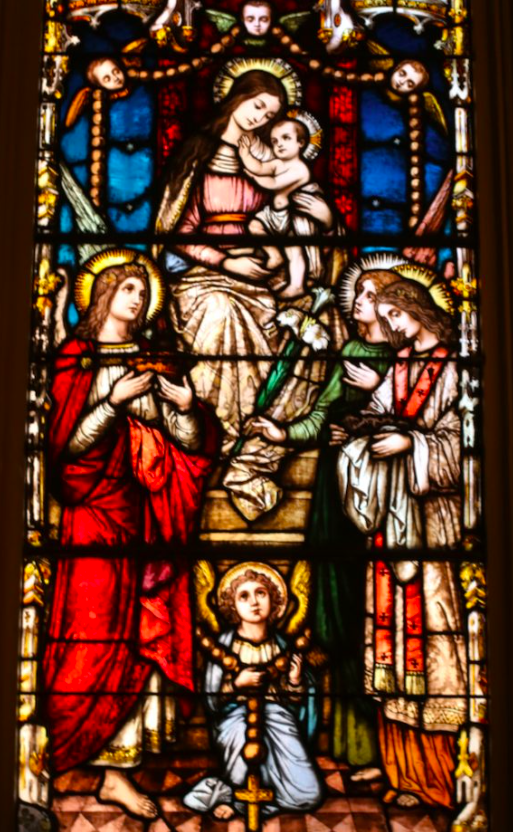
Beginning this Friday, August 5, the First Friday of the month, a group will be meeting at St. Mary’s Church, Norwalk, CT, to attend the 8 am Traditional Mass and pray the Rosary for the continuation of the Traditional Mass in the Diocese of Bridgeport, in our nation, and in the Church worldwide.
We will be praying in particular for Bishop Caggiano, who has so far recognized and appreciated the vitality of Latin Mass communities in the Diocese. But many bishops are now prohibiting Traditional Masses, either drastically cutting down or eliminating them completely.
It is urgent right now to pray that God will protect our access to the Traditional Mass and bless our priests who celebrate the Traditional Mass.
Please join us by attending the 8 am Traditional Mass at St. Mary’s Norwalk every Friday in August, starting this Friday, and stay for recitation of the Holy Rosary. If you cannot be there, consider uniting yourself in prayer.
Please invite your friends and family.
On a related note, this Novena to Blessed Michael McGivney is circulating:

29
Jul
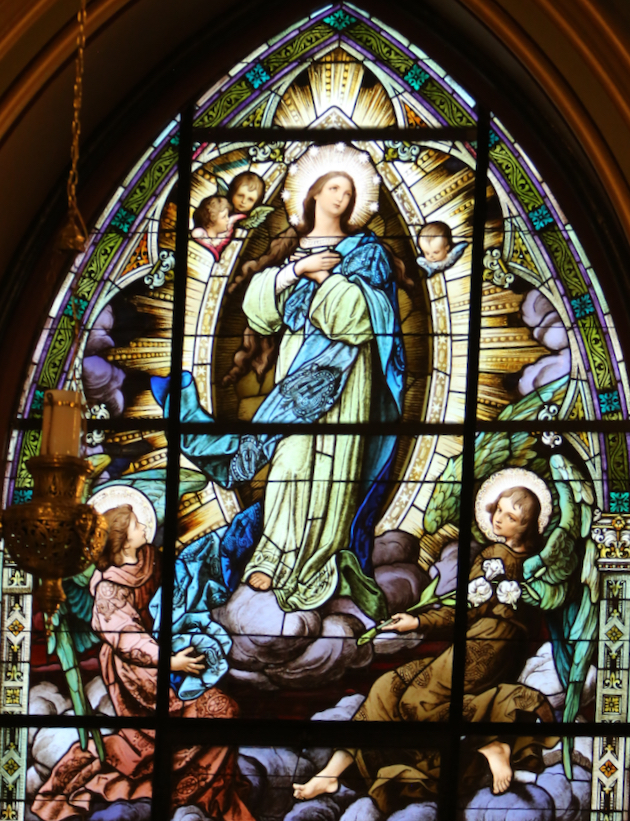
The Feast of the Assumption of the Blessed Virgin Mary, a holy day of obligation, is on Monday, August 15. The following churches will offer the Traditional Mass on August 15th. Please notify us with additional information.
Connecticut
St. Mary Church, Norwalk, CT, 8 am, low Mass.
Sts. Cyril and Methodius Oratory, Bridgeport, 7:45 am low Mass, 6 pm Solemn Mass. Blessing of herbs: Please place fresh herbs for the traditional blessing on the table by the statue of Our Lady of Grace before Mass.
St. Patrick Oratory, Watebury, CT, 8am Low Mass; 6pm High Mass and Benediction
Oratory of the Most Sacred Heart, Georgetown, CT, Missa Cantata, 6 pm.
St. Marguerite Bourgeoys, 138 Candlewood Lake Road, Brookfield, CT, 07:00 am Low Mass.
St. Pius X, Fairfield, CT, 7 pm Solemn Mass
St. Martha Church, Enfield, CT, 7 pm
New York
Holy Innocents, New York, NY, 8 am low Mass; 6 pm Missa Cantata
Our Lady of Mount Carmel, New York, NY, 7 am and 7:45 am Low Masses; 7 pm Missa Cantata.
St. Josaphat, Bayside (Queens), 7pm
St. Matthew, Dix Hills, NY (Long Island) , 10:30 AM.
St. Rocco, Glen Cove (Long Island), 7pm
St. Paul the Apostle, Yonkers, NY, 12 noon
Annunication-Our Lady of Fatima, Crestwood, NY, 7:30 pm Solemn Mass followed by a Marian Procession through Crestwood.
Immaculate Conception Church, Sleepy Hollow, NY, Low Mass, 7 pm
Sacred Heart in Esopus NY, 11 am
St Mary-St Andrew, Ellenville, NY, 7 pm Missa Cantata
New Jersey
Our Lady of Sorrows, Jersey City, 7 pm.
Our Lady of Victories, Harrington Park, NY, 5:30 pm, low Mass.
Shrine Chapel of the Blessed Sacrament, 52 West Somerset St., Raritan, NJ, Solemn Mass 7 pm.
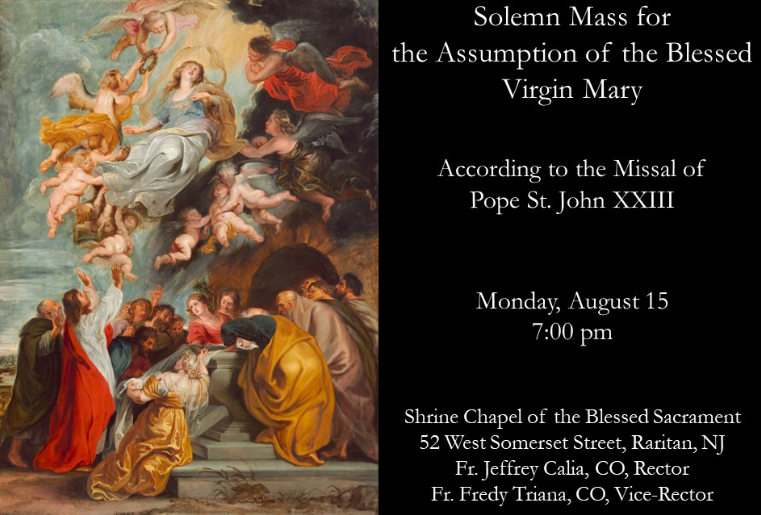
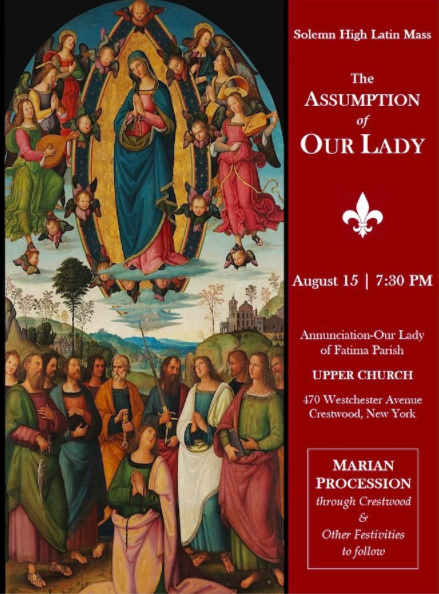
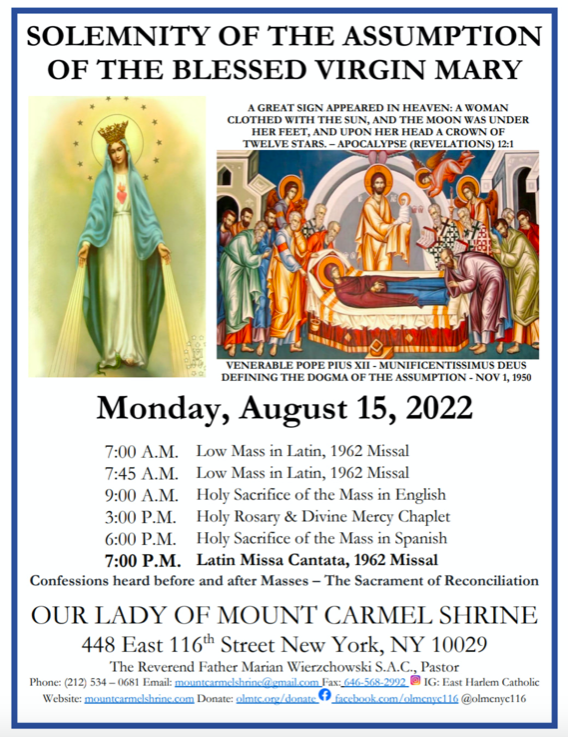
25
Jul
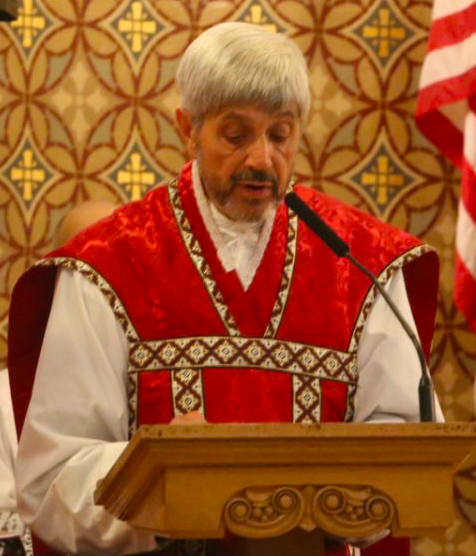
Sermon by Fr. Richard Cipolla for the Feast of St. James given this evening at the Church of St. Pius X in Fairfield, CT.
One of the most dramatic scenes in the gospels is the calling by Jesus of James and
John. They are in their fishing boat with their father, Zebedee. And Jesus calls to
them: Come, follow me and I will make you fishers of men. So they drop their
nets, get out of the boat, leave their father behind and follow Jesus as the first two
of his disciples, who will become his apostles at Pentecost. I have always been
impressed by the clarity of this scene and the cutting away of any small talk: Come
follow me. And they left their nets and followed him.
It is James and John who are chosen with Peter to walk up the mountain to witness
what we call Jesus’ transfiguration. It is James and John with Peter who
accompany Jesus after the Last Supper when he goes to pray in the Garden of
Gethsemane. But it is also James and John who pull Jesus aside one day to ask
him if he would see to it that one of them sat on his right and the other on his left
when they reached heaven. They, like Peter, did not really understand what
following Jesus meant. James found out after Pentecost, when he became a true
apostle who proclaimed the person of Jesus Christ as Lord and Savior both in
Jersusalem and in Spain. Tradition tells us that he was martyred in Jerusalem and
that his body was then carried to Compostela in Spain where he was buried.
The pilgrimage to St James’ tomb in Compostela became, as we all know, one of
the most important pilgrimage sites in the Middle Ages and beyond. People
walked from all over what we now call Europe, some for hundreds of miles, to this
shrine, as pilgrims and penitents. There has been in the recent past a revival of
Catholics making this pilgrimage, as a sign of their faith in Christ and his apostle
James, who finally understood that the heart of faith in Christ is being willing to
partake of the suffering of the Cross, which alone leads to the joy of the
resurrection. I have been to Compostela and prayed at the tomb of St. James. I
wish I could tell you that I walked many miles over the mountains to get there.
The fact is that I officiated at a lovely wedding in the north part of Portugal, and
the groom graciously offered the use of his Mercedes after the wedding so I could
drive to Compostela. And so I went in style, but I did pray there, that I would
remember what Jesus told St. James about glory in heaven: no suffering, no glory.
21
Jul
This Saturday: Traditional Mass pilgrimage to the beautiful shrine church of Our Lady of Mt Carmel, 448 E 116th St, New York
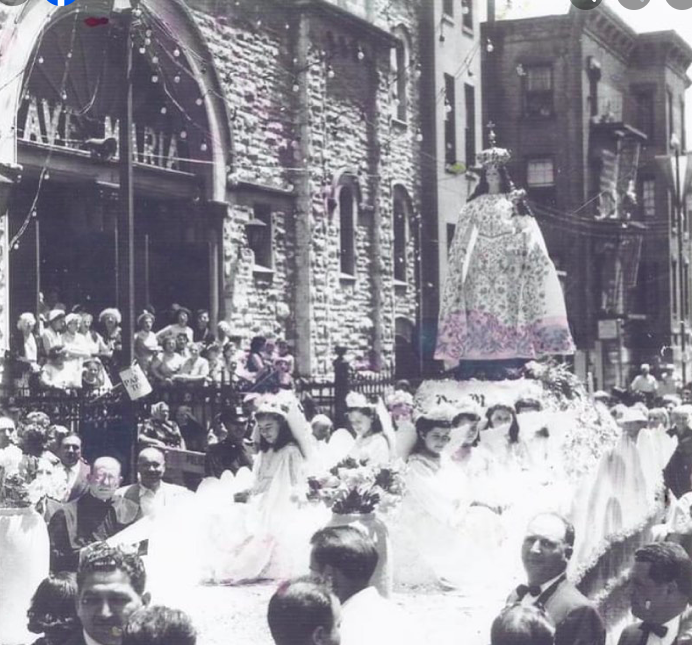
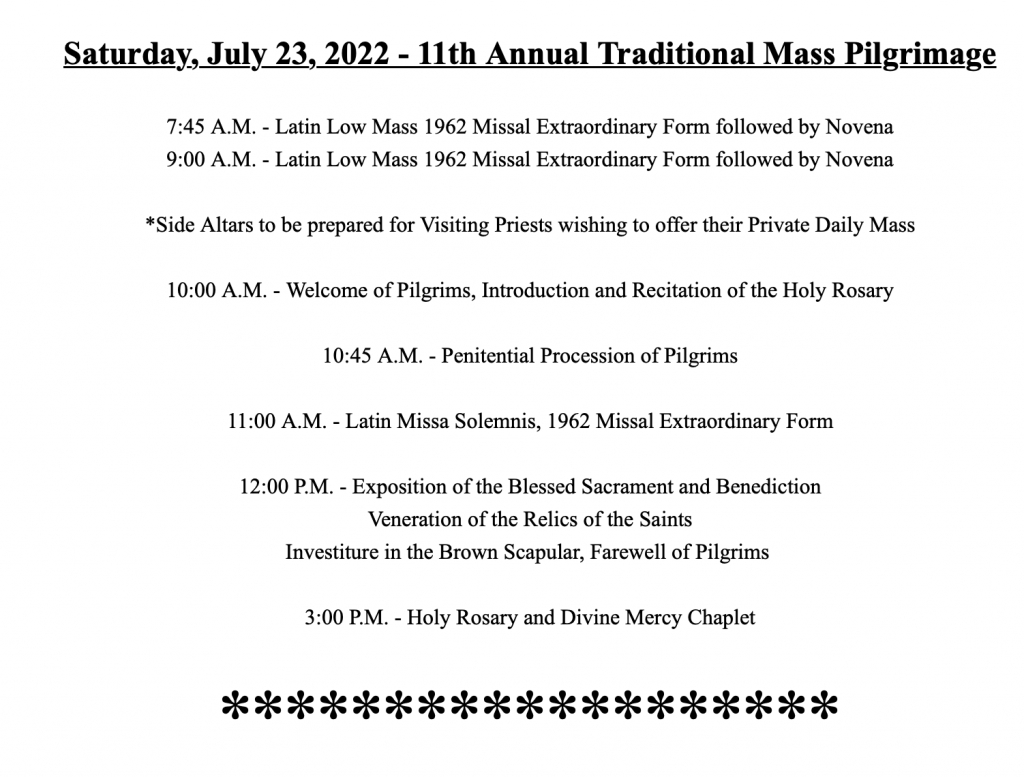
19
Jul
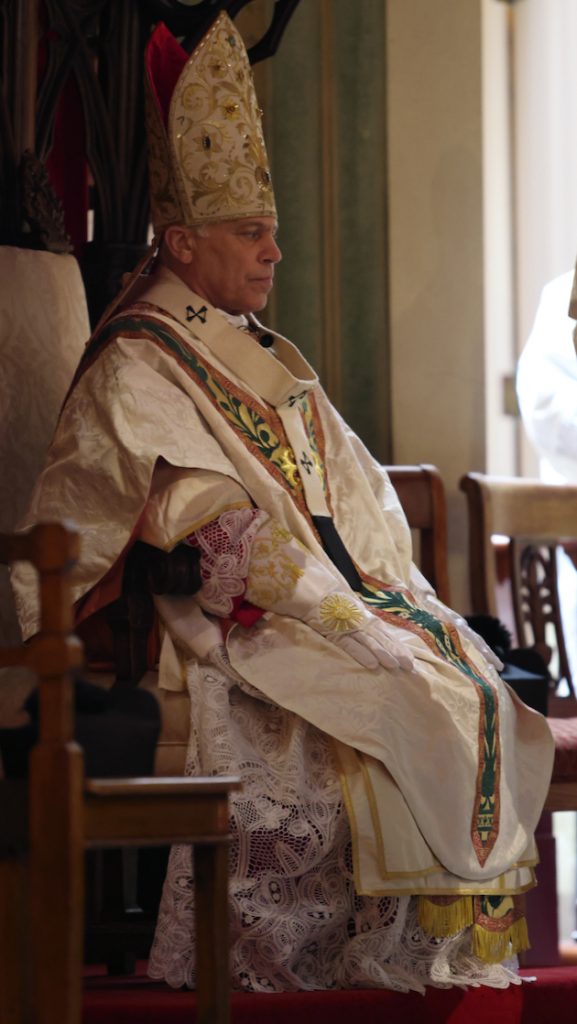
A Connecticut atelier, Sacra Indumenta, provided vestments for the Solemn Pontifical Mass in San Francisco on July 1 (we posted our pictures yesterday here). Archbishop Cordileone was wearing a pontifical alb specially designed and tailored by owner Susan-Jayne Caballero, who operates out of Norwalk, Connecticut. Mrs. Caballero is well-known in Connecticut and the New York area for her beautiful heirloom-quality bespoke sacred vestments. But we were pleasantly surprised to find out, when we attended the Pontifical Mass in San Francisco, that her reputation has spread to the west coast. You can read more about this amazing firm on the Sacra Indumenta website.
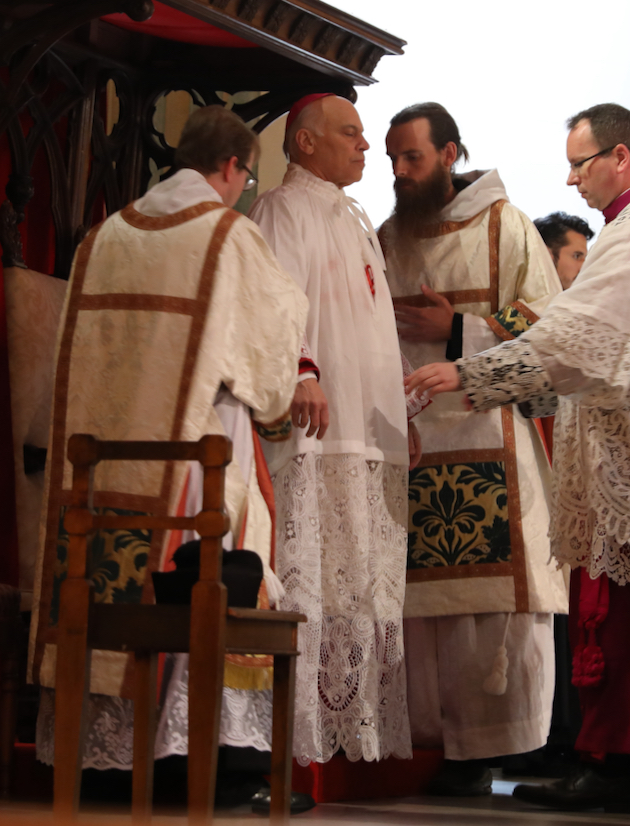
These notes written by Susan-Jayne Caballero, will impress on you the detail that went into the design and tailoring of this one vestment piece:
This Pontifical Alb is 100% pure lightweight Irish linen with special commission Italian hand-made lace from a renowned lace designer in Italy, GALBIATI. The cuffs are lined in pure silk moiré in the crimson from Gammarelli in a shade designated for prelates (as opposed to Cardinal red). The lace is engineered into a continuous panel for the skirt with decorative floral and cruciform motifs and accompanied by coordinated paraments for the sleeve overlay.
I designed a completely custom new pattern with particular vintage details for the shoulder construction and worked with a close friend who is an historical pattern maker, and historical costume museum curator and embroidery artist (Shaina Dombrowik who owns Deciphering Designs). Since I own quite a few vintage pieces, I studied several and worked with Shaina to digitize a custom alb pattern to fit His Excellency that incorporates the vintage construction techniques.
This particular shoulder construction is seen on many vintage albs for securing the neck and shoulder intersection which eases the stress point at that intersection. It is essentially a bias cut godet and allows a bit of flexibility between the shoulder bands and the neck collar band where the micro bunch pleating has gathered in the fullness of the body of the Alb. See here a photo from an Instrgram post where I detailed this construction in progress before setting the collar band.

I added matching white floral embroidery to the placket end point as well as as to each point of the godets on the shoulder bands.
Throughout the entire neckline outer edge, shoulder inset and along placket opening in front, I detailed with 1/4” fine Cluny scallop lace which traditionally protected the placket and collar edges from wearing or soiling badly from perspiration and abrasion. It’s not just decoration! Similar to how collar and stole protectors guard chasubles and stoles and are changed out every so often.
The sleeve moiré silk and lace overlay are both basted on and can be removed fairly easily for cleaning and lovingly basted back to the linen sleeve body.
The tie is a double face cotton sateen with a small bunched pleat at the ends to help the ends lay flat and stay put and prevent it from curling with use.
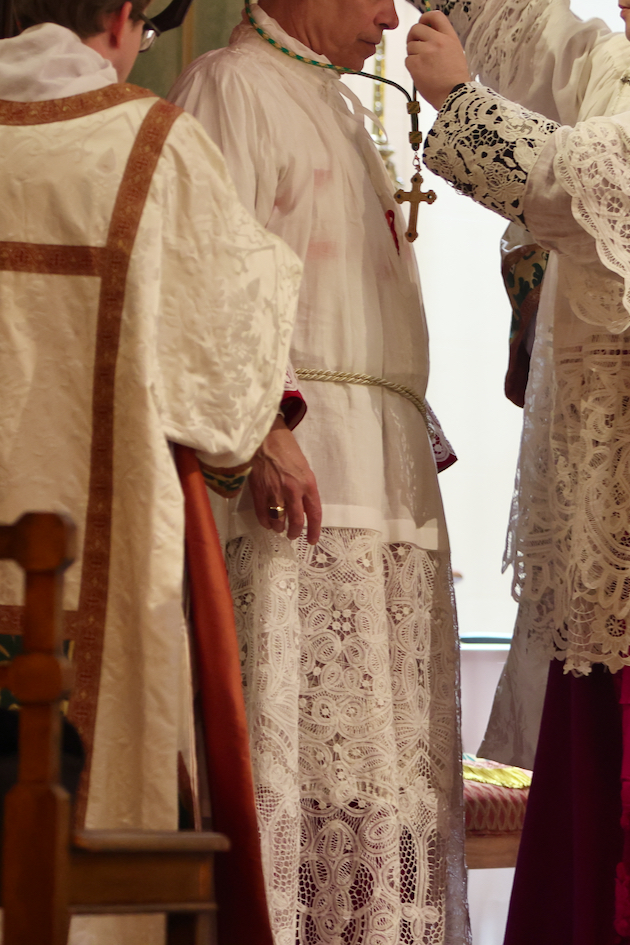
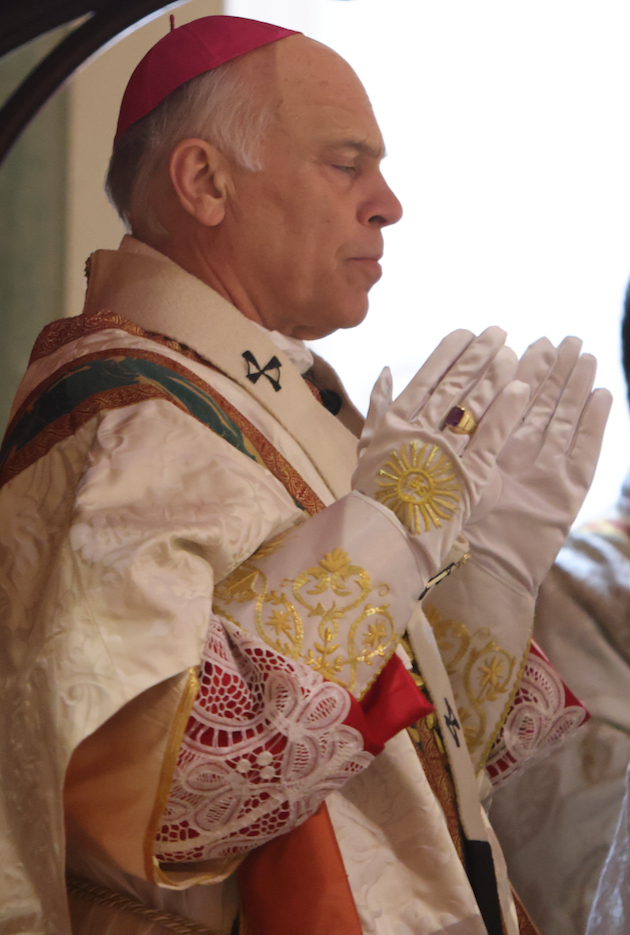
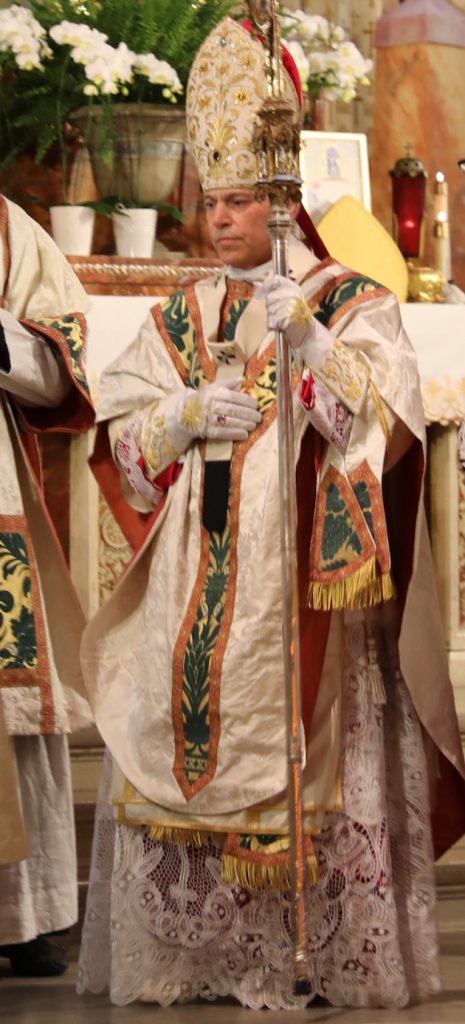
In addition, four of the acolytes at the Mass wore surplices made by Sacra Indumenta.


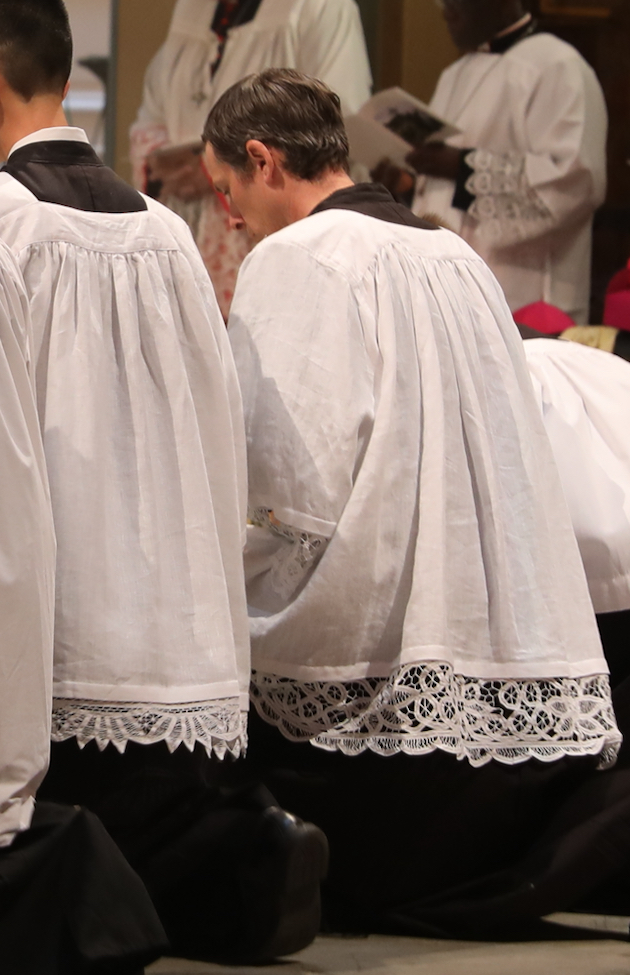
n.b. The silk Mass set, including the Spanish chasuble, were also made by an American firm, Altarworthy. For more information see:
https://www.liturgicalartsjournal.com/2022/07/vestments-commissioned-for-solemn.html?fbclid=IwAR0825M0-AxH-KCziVwHAybTJXJpdTvvSv6CRbmPoxWgl-W7i-
For further reading: we also posted an article by Susan-Jayne Caballero a few years ago on the art of creating sacred vestments.
Contact us
Register
- Registration is easy: send an e-mail to contact@sthughofcluny.org.
In addition to your e-mail address, you
may include your mailing addresss
and telephone number. We will add you
to the Society's contact list.
Search
Categories
- 2011 Conference on Summorum Pontifcum (5)
- Book Reviews (95)
- Catholic Traditionalism in the United States (24)
- Chartres pIlgrimage (17)
- Essays (176)
- Events (670)
- Film Review (7)
- Making all Things New (44)
- Martin Mosebach (34)
- Masses (1,343)
- Mr. Screwtape (46)
- Obituaries (15)
- On the Trail of the Holy Roman Empire (22)
- Photos (347)
- Pilgrimage Summorum Pontificum 2021 (7)
- Pilgrimage Summorum Pontificum 2022 (6)
- Pilgrimage Summorum Pontificum 2023 (4)
- Sermons (79)
- St. Mary's Holy Week 2019 (10)
- St. Mary's Holy Week 2022 (7)
- St. Mary's Holy Week 2023 (7)
- St. Mary's Holy Week 2024 (6)
- Summorum Pontificum Pilgrimage 2024 (2)
- Summorum Pontificum Pilgrimage 2025 (7)
- The Churches of New York (198)
- Traditionis Custodes (49)
- Uncategorized (1,377)
- Website Highlights (15)
Churches of New York
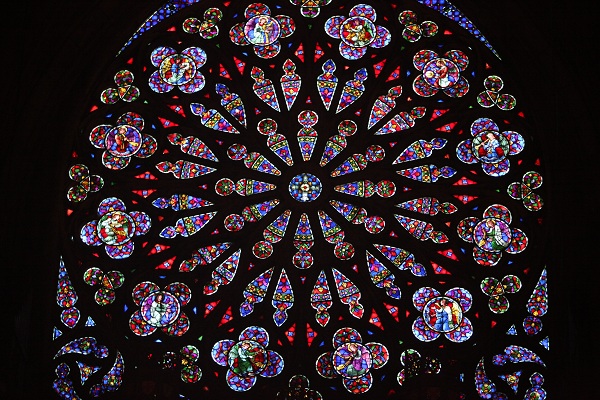
Holy Roman Empire

Website Highlights
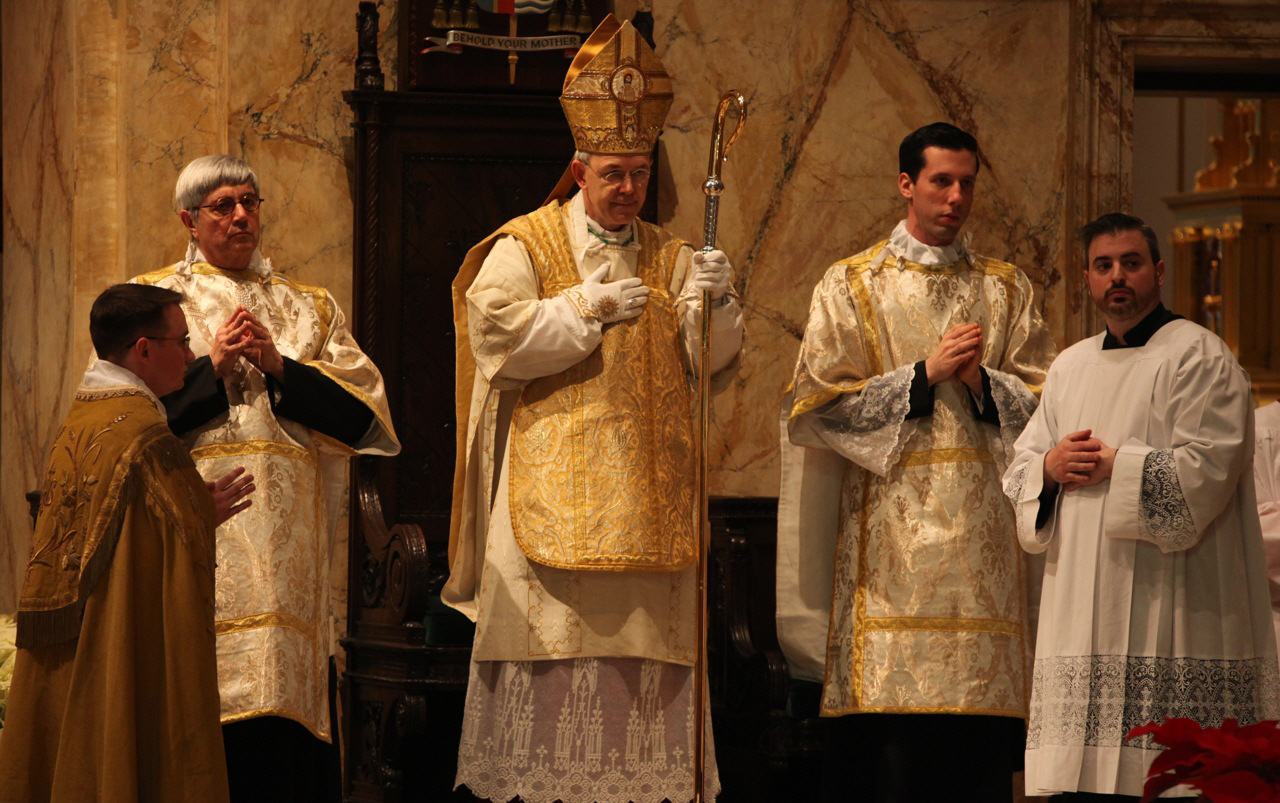
Archives

[powr-hit-counter label="2775648"]
